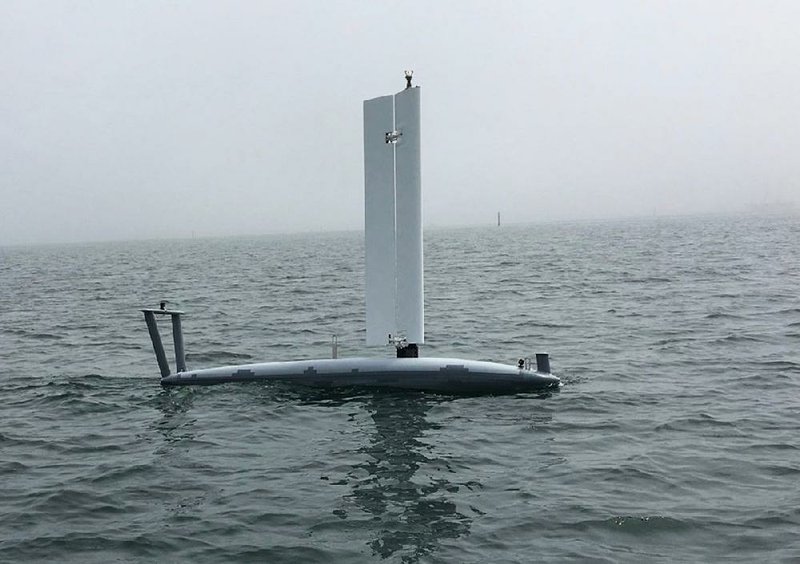More than a decade after airborne drones took flight over battlefields, the world’s biggest defense manufacturers are eyeing a new market below the ocean’s surface.
The Navy recently opened up a competition for unmanned submarines that can navigate autonomously. Chicago-based Boeing has taken an early lead in the fledgling market. The company has developed a 51-foot-long vessel called the Echo Voyager to compete for the contract, and last year it bought a company called Liquid Robotics that focuses on smaller unmanned subs.
Bethesda, Md.-based competitor Lockheed Martin is also competing for the contract, a company spokesman said, and it, too, is now ramping up its efforts by investing in another company specializing in the autonomous watercraft.
The company’s technology investment unit, Lockheed Martin Ventures, is backing a San Diego-based company called Ocean Aero, which makes various classes of seafaring drones, termed unmanned underwater vehicles, or UUVs. The size and terms of the transaction were not disclosed. The venture unit typically makes investments of $1 million to $5 million.
“This just speaks to how big the unmanned systems market has become, that you have Boeing and Lockheed going at this full speed,” Ocean Aero Chief Executive Eric Patten said.
Ocean Aero makes a 13-foot-long, battery-powered submarine called the Submaran S10. The S10 can loiter on the surface or dive to a relatively shallow 30 feet. It can navigate autonomously based on preprogrammed way-points and is outfitted to scout for and hide from threats completely on its own. It can recharge its battery on the surface using tiny solar panels or raise a sail to harness the wind for propulsion, which the manufacturer calls “energy scavenging.” The S10 has already been sold to two undisclosed customers.
The company plans to introduce a larger model called the S200 next year that can travel faster and dive deeper. It is about to start testing a 39-foot-long model it calls the Silent Arrow that aims to dive to about 650 feet and navigate with the help of an electronic thruster.
Patten says the Silent Arrow submarine positions the company for future Navy competitions.
“When the competition started in January, we weren’t in a position to compete,” he said. “Now we’re in a position to compete for that.”
Ocean Aero is part of a nascent yet crowded field of startups that has emerged in tandem with smaller, more fail-safe lithium-ion batteries.
The industry is responding to a new school of thought in the upper echelons of the U.S. military. Agencies are looking to use advances in robotics and artificial intelligence as “force multipliers,” with the idea that combat-capable robots will augment but not replace humans in the wars of the future.
The Air Force is working on robotic drones that would fly alongside fighter jets, scout ahead and absorb enemy fire. The Army is experimenting with small-scale reconnaissance robots. Even U.S. law enforcement officers are buying in. Last year Dallas police used a robot outfitted with C-4 explosives to remotely kill a gunman who had killed five police officers.
Some worry that involving robots in military operations could imperil human lives and inflame conflict.
In August, Tesla Chief Executive Elon Musk and 115 robotics and artificial intelligence experts wrote an open letter to the United Nations urging the body to “protect us all” from autonomous weaponry, describing it as a dangerous escalation in military technology.
“Once deployed, they will permit armed conflict to be fought at a scale greater than ever, and at time scales faster than humans can comprehend,” they wrote.
“These are weapons of terror, weapons that despots and terrorists use against innocent populations, and weapons hacked to behave in unexpected ways.”
Lockheed and Boeing argue that the robotic submarines could one day become the Navy’s robotic scouts, augmenting the efforts of the Navy’s limited and aging fleet of manned submarines.
“My main challenge in the Navy was there were many demands for what people wanted a submarine to do and you couldn’t come close to meeting all of them,” said Mike Connor, a retired Navy vice admiral and submarine force commander who now runs a company called ThayerMahan.
Autonomous watercraft “could make each one of those submarines and destroyers that much more powerful and impactful by orders of magnitude,” he said.
Ocean Aero’s robotic submarines are likely to be priced in the hundreds of thousands of dollars each, and in the tens of millions for the larger models. That’s significantly cheaper than the manned nuclear submarines that now patrol the waters.
Ocean Aero’s robotic submarines “can’t do everything a normal submarine can do, and we would probably never want them to,” Patten said. “But they can be tasked with things that might waste a normal submarine’s time. It would free up the more capable submarines.”
For now, the small submarines are being pitched mainly as a surveillance tool. Officials at Lockheed Martin say Ocean Aero’s submarines are most likely to be used to map maritime threats, similar to how U.S. military and intelligence agencies already use satellites and aerial drones to collect information from above.
“We’ll be putting eyes and ears more distant from the force to collect information,” said Chris Moran, executive director of Lockheed Martin Ventures.
But more dangerous missions could soon follow for the Navy’s robots.
The Navy has actively tested unmanned underwater drones’ ability to find and disable mines, hoping they will one day protect aircraft carriers in hostile territory. It’s not out of the question that the robotic submarines could be used to actively attack enemy submarines.
Ocean Aero’s Silent Arrow, its largest submarine at 39 feet long, can carry up to 2,000 pounds worth of equipment, meaning it theoretically could be outfitted with advanced weaponry.
“It can carry a pretty large payload,” Lockheed’s Moran said. “That was one of the big attractions for us.”

